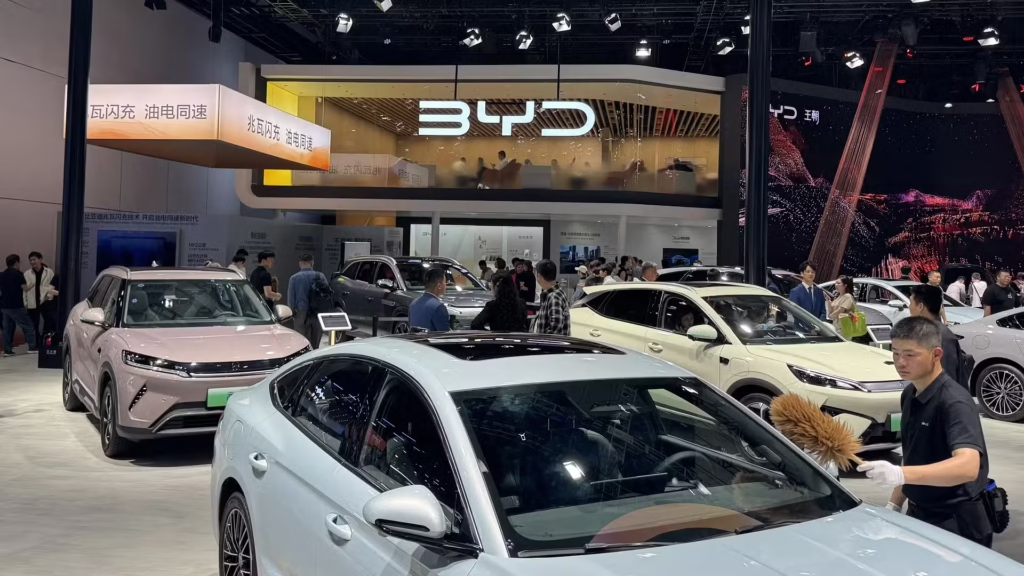
The Shanghai Motor Show stands as a colossal stage where the automotive world’s present and future collide. With over 30 million new cars sold annually in China alone and featuring around 150 distinct car brands, the scale of innovation and competition is unparalleled. In this article, we’ll dive into some of the show’s most exciting reveals, from the revival of powerful V8 engines and advancements in plug-in hybrid technology to the emergence of flying cars and the integration of cutting-edge infotainment systems. We’ll explore how these innovations are not only shaping the Chinese market but also influencing the global automotive landscape, offering a tantalizing glimpse into what we might see on our roads in the years to come. The show isn’t just about showcasing vehicles; it’s a testament to the rapid evolution of automotive technology and design, driven by intense competition and a relentless pursuit of innovation.
GWM’s V8 Comeback
- New V8 Engine: GWM is launching a new 4.0L V8 engine, paired with a plug-in hybrid drivetrain.
- Tank 300 Hook Concept: A concept car showcasing the V8, featuring a live front axle and serious off-road capabilities.
- Future Applications: This engine may be used in other GWM vehicles like the Tank 500 and 700, and even in a larger ute to compete with the F-150.
Great Wall Motors (GWM) made headlines at the Shanghai Motor Show with the unveiling of a new 4.0L V8 engine, signaling a bold move in an era increasingly dominated by electric vehicles. This engine, slated to be part of a plug-in hybrid drivetrain, is not just about raw power; it represents a strategic play to cater to a specific demand for high-performance off-road vehicles. The concept car showcasing this engine, the Tank 300 Hook, is a beast with a live front axle and aggressive styling, promising serious off-road capabilities.
What makes this announcement particularly significant is GWM’s intention to roll out this engine across various models, including larger utes and SUVs. This move suggests a broader strategy to capture a segment of the market that values both power and off-road prowess. While detailed specifications and outputs are still under wraps, the potential of this V8, combined with a plug-in hybrid system, could redefine expectations for off-road performance. It remains to be seen how this engine will sound and perform in real-world conditions, but the initial buzz is undeniable.
Plug-In Hybrid Innovation
- New Hybrid Setup: GWM is evolving its plug-in hybrid technology to remove the drive line, moving the battery away from the rear for better performance.
- Tank 400: A near-production model likely coming to Australia, featuring a massive infotainment screen and a luxurious interior.
- Off-Road Focus: GWM aims to improve off-road capabilities in its plug-in hybrids, learning from the shortcomings of models like the BYD Shark.
Beyond the V8 engine, GWM is also focusing on advancing its plug-in hybrid technology. A key innovation is the move to remove the traditional drive line, which allows for better battery placement and improved performance characteristics. This approach is more akin to what we see in the BYD Shark, but GWM is keen to avoid the off-road capability issues that have plagued that model. By moving the battery away from the rear, GWM aims to enhance handling and overall performance, albeit with a potentially higher center of gravity.
The Tank 400, a model likely destined for Australian shores, exemplifies this new direction. With its rugged design, enormous infotainment screen, and luxurious interior, it showcases the value-for-money proposition that Chinese cars are increasingly known for. The combination of advanced technology, luxurious appointments, and competitive pricing positions the Tank 400 as a compelling option in the off-road SUV market. This focus on plug-in hybrid technology reflects a broader trend in the industry, as manufacturers seek to bridge the gap between traditional combustion engines and full electrification.
Nissan’s Frontier Pro Concept
- Plug-In Hybrid Ute: Nissan is signaling a move to plug-in hybrid with the Frontier Pro concept, showcasing a potential future Navara.
- New Platform: Navara and Frontier might move to a shared platform, accommodating both internal combustion engines and plug-in hybrid systems.
- Premium Interior: The concept features a luxury vibe with advanced infotainment screens and off-road features like front and rear diff locks.
Nissan’s Frontier Pro concept is another highlight of the Shanghai Motor Show. This plug-in hybrid ute offers a glimpse into the future of the Navara, showcasing a rugged design and a luxurious interior. Nissan is planning to move the Frontier and Navara to a shared platform, which would allow for the integration of plug-in hybrid systems and potentially larger V6 engines. This move reflects a strategic shift towards electrification while retaining the core capabilities that ute buyers demand.
The Frontier Pro concept boasts a range of impressive features, including full LED lighting, all-terrain tires, and a premium interior with advanced infotainment screens reminiscent of BYD systems. The inclusion of front and rear diff locks underscores Nissan’s commitment to off-road capability, while the innovative tray design with a folding step adds a touch of practicality. The rolling chassis reveals a traditional drive line with a four-cylinder gasoline engine and a centrally located battery pack, promising decent driving range and vehicle load capability.
The combined power and torque output of over 220 kW and 800 Nm is impressive, suggesting that Nissan is serious about delivering a high-performance plug-in hybrid ute. While the exact details of the powertrain and its integration with Mitsubishi’s existing plug-in hybrid technology remain unclear, the Frontier Pro concept is a compelling vision of the future for Nissan’s ute lineup.
BYD’s Electric Innovations
- SINE 5: BYD’s new ATTO 3 SUV, priced from $25,000 in China, offers a smaller, more affordable electric SUV option.
- Battery Swapping: NIO’s battery swapping technology offers a quick alternative to EV charging, though challenges remain around battery ownership.
- Advanced Technology: BYD showcases its God’s Eye autonomous driving system and innovative features like roof pods with integrated drones.
BYD continues to be a dominant force in the electric vehicle market, and the Shanghai Motor Show provided further evidence of its innovation. The SINE 5, a new ATTO 3 SUV priced from $25,000 in China, offers a smaller, more affordable electric SUV option. With its decent range, stylish interior, and advanced features like BYD’s God’s Eye autonomous driving system, the SINE 5 is set to appeal to a broad range of buyers.
Another notable innovation is NIO’s battery swapping technology, which offers a quick alternative to EV charging. While challenges remain around battery ownership and standardization, the ability to swap a depleted battery for a fully charged one in minutes is a compelling proposition. BYD also showcased its advanced autonomous driving systems and innovative features like roof pods with integrated drones, highlighting its commitment to pushing the boundaries of electric vehicle technology.
The Future is Electric
- CATL’s Advanced Batteries: CATL is developing batteries with 1,500 km of range and ultra-fast charging capabilities.
- Flying Cars: Multiple brands showcased flying car concepts, though practical considerations and regulatory hurdles remain.
- Shifting Market Dynamics: Traditional brands like Toyota and Mercedes-Benz are facing increasing competition from innovative Chinese brands.
The Shanghai Motor Show made it clear that the future of the automotive industry is electric, and Chinese brands are leading the charge. CATL’s development of batteries with 1,500 km of range and ultra-fast charging capabilities is a game-changer, addressing two of the biggest concerns for EV buyers: range anxiety and charging time. While challenges remain, the progress being made in battery technology is undeniable.
The proliferation of flying car concepts is another intriguing trend, though practical considerations and regulatory hurdles remain. It is interesting to observe established car manufacturers such as Toyota and Mercedes-Benz, their presence felt subdued compared to the local, pioneering brands. The shift shows the traditional titans of car manufacturing are having to play catch up and innovate to keep in step with the new players in the market.
The Shanghai Motor Show is a showcase of the incredible pace of change in the automotive industry. With Chinese brands leading the way in electric vehicle technology, plug-in hybrid innovation, and advanced autonomous driving systems, the future of transportation is shaping up to be very different from what we imagined just a few years ago. This motor show is not just a glimpse into the future; it’s a catalyst for change, driving innovation and competition across the global automotive landscape.
Conclusion
The Shanghai Motor Show delivered a resounding message: the automotive future is here, and it’s being shaped at an unprecedented pace. From GWM’s bold V8 comeback and Nissan’s innovative plug-in hybrid ute to BYD’s electric dominance and CATL’s revolutionary battery technology, the show was a melting pot of groundbreaking innovations and forward-thinking designs. The emergence of flying car concepts and the integration of advanced autonomous driving systems further underscored the industry’s relentless pursuit of progress. Observing the innovation occurring at the motor show enables one to form a clearer picture of the future of Chinese automotive and related technologies.
As traditional automotive giants like Toyota and Mercedes-Benz grapple with shifting market dynamics, Chinese brands are seizing the opportunity to lead the charge, challenging established norms and pushing the boundaries of what’s possible. The value-for-money proposition offered by Chinese cars, coupled with their rapid adoption of cutting-edge technology, is reshaping consumer expectations and forcing global automakers to rethink their strategies.
The Shanghai Motor Show has been a great place to look and wonder about what tomorrow might hold. For anyone passionate about cars, or anyone wanting to keep up with how new tech could change our roads, this event is genuinely insightful. What do you think about the future of automotive? Will electric vehicles fully take over, or will plug-in hybrids and other technologies continue to play a significant role? Let us know your thoughts in the comments below.
FAQ
-
- What was the Shanghai Motor Show about?
The Shanghai Motor Show is one of the largest and most influential automotive shows in the world, showcasing the latest vehicles, technologies, and innovations from both Chinese and international manufacturers.
-
- What were the highlights of the show?
Highlights included GWM’s new V8 engine, Nissan’s Frontier Pro plug-in hybrid concept, BYD’s SINE 5 electric SUV, CATL’s advanced battery technology, and various flying car concepts.
-
- Are Chinese cars any good?
Yes, Chinese cars have improved significantly in recent years and now offer competitive performance, features, and value for money.
-
- Will these cars come to Australia?
Some of the vehicles showcased at the Shanghai Motor Show are expected to be available in Australia in the future.






